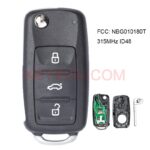Experiencing issues with your Mazda 6 key fob? A common culprit is a dead or dying battery. Before assuming you need a costly replacement key fob, often a simple battery change and reprogramming can get you back on the road. This guide will walk you through how to change the battery in your Mazda 6 key fob and then reprogram it yourself, saving you time and money.
Changing the Battery in Your Mazda 6 Key Fob
While this guide focuses on reprogramming, let’s quickly cover the battery change itself, as it’s the first and easiest step. Typically, you’ll need a small Phillips head screwdriver or a flathead screwdriver depending on your key fob model and a CR2025 or CR2032 battery – check your owner’s manual or the markings inside your key fob for the exact type. Carefully open the fob casing, remove the old battery, and replace it with a new one, ensuring correct polarity (+ side up).
Step-by-Step Guide to Reprogramming Your Mazda 6 Key Fob
If changing the battery doesn’t immediately solve the problem, or if you’ve replaced the battery and your key fob still isn’t working, you’ll likely need to reprogram it to your Mazda 6. Follow these steps carefully:
-
Get Ready: Ensure all doors are closed and the driver’s door is open. Remove the key from the ignition.
-
Lock and Unlock: Use the power lock switch located on your driver’s side door panel to manually lock and then unlock the driver’s door.
-
Ignition Cycle – Part 1: Insert your key into the ignition. Turn the key to the “ON” position (just before starting the engine, where the dashboard lights come on) and then back to the “OFF” position. Repeat this “ON-OFF” cycle three times within 10 seconds. Leave the key in the ignition in the “OFF” position after the third cycle.
-
Door Cycle: Open and close the driver’s door three times, ending with the door in the open position. Tip: You can use the door jamb switch to simulate opening and closing the door if it’s easier than physically moving the door.
-
Lock Response: At this point, the door locks should automatically cycle (lock and unlock). This indicates that your Mazda 6 has entered programming mode. Important: If you see the locks cycle, proceed immediately to the next step.
-
Remote Activation: Take your key fob remote and press any button on it twice. Press the button firmly and ensure you press it two times only, no more, no less. The door locks should cycle again (lock and unlock) to confirm successful programming of that remote. Success Indicator: If the locks cycled after pressing the remote button twice, the programming for this remote is complete! You can now remove the key from the ignition.
-
Programming Additional Remotes (Optional): If you have a second key fob to program, immediately press any button on that second remote twice. Again, the door locks should cycle to confirm programming.
-
Final Confirmation: Remove the key from the ignition. The door locks should cycle one last time (lock and unlock).
-
Test Your Remotes: Thoroughly test all programmed key fobs to ensure they are working correctly by locking, unlocking, and activating other functions like the panic button if applicable.
If you’ve followed these steps and your Mazda 6 key fob still isn’t responding, consider these troubleshooting tips:
- Check Fuses: Inspect your car’s fuse box for any blown fuses related to the keyless entry system.
- Battery Check (Again): Double-check that you installed the correct type of new battery in the key fob and that it’s properly seated.
- Remote Condition: If you’ve tried reprogramming multiple times, the key fob itself might be faulty and require replacement.
- Seek Professional Help: If all else fails, it’s best to consult a qualified automotive locksmith or your local Mazda dealership for further diagnosis and assistance.
By following these instructions, you should be able to change your Mazda 6 key fob battery and reprogram it effectively, restoring the convenience of your keyless entry system.
